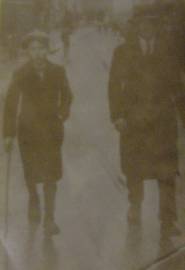
Coming Home from the Fair
The photo on the right was taken in the 1930s. It shows Jack Hickey and his
son Johnnie coming down High Street, Kilkenny. You can just see the Town Hall
in the background. They are coming home from a fair. there isn't much traffic,
they are walking in the middle of the street.
Source: Josie Hickey.
Fairs
This information was given to us by Geoff Brennan, Mikey, Paddy and Del Quirke and Joe Nolan.
Cattle were sold in Fairs before cattle marts were established. The local Fairs were held in Kilkenny, Ballinakill, Urlingford Rathdowney and Freshford. In the last century, there was a fair held in Rathbeagh.
On the evening before the Fair arrangements were made with neighbours who were also selling, and local men who could be hired for the day to travel together. It made the driving and control of cattle easier both on the road and on the Fair.
The strong farmer would mark his cattle. This was done by dipping a jam jar in paint and putting a ring on the animal's back. Others had letters. Cattle were held in handy paddocks or yards near the house. Farmers usually had between three and five animals.
Most people would not go to bed at all. It was important to get to the fair at day break. Men would eat before leaving. A start would be made between 2 and 3 am. Oil lamps and bónneáns (sticks) were carried by the walkers. The stronger farmer went in a pony and trap. The difficulties on the road were gateways, other cattle, lanes and travellers camps. On the way if cattle were breaking back it was considered good luck for the day.
"Blockers"
By the time they got to "The Rock" on the way to Kilkenny they would have met the first of the "Blockers". These worked for dealers and buyers.
Dealers
When they came near the town they met the dealers. Some of the dealers were: Jack Barrett, Ignatius Byrne, Mr Doyle, Ganley and Sons, Mr Lyons, Mr McGonagle, Mr Sheridan, Mr Kelly and Smith and Griffin, McMolloy who's family still trade in Waterford.
Dealers moved through the stream of stock as they made their way to the Fair Green. The dealers had a fixed idea of the type of stock they required e.g. heifers, stores or bullocks. On the Fair Green stock was held in clusters. By this time stock were tired and it was easy to keep them together. It was seldom a deal was done between a buyer and seller.
A buyer would come and look and make a low offer. He would have someone with him. There were also others around e.g. the blockers from early morning who were interested in a deal taking place. The buyer and his companion would walk away. The third party would then call back the dealer saying "This decent man will deal". The farmer would not deal, he would stand his ground and look disinterested whereupon, the third party would catch his waist and pull out the palm of his hand and say "Sure you won't break me word" and mention a figure appoximately half way between the two.
After haggling for a long while a deal was usually done. The hand was spat on and slapped to seal the deal. There would be a cheer from the people around. Then there was the bigger "thief". He would wait around until someone's back was against the wall and had to sell. He would get the cattle cheap. There would be no hand slapping and he was a farmer. Most buyers would have their cattle bought by 11 o'clock. Their initials or mark would be clipped on the animals hair. The seller got a docket and instructions as to where the cattle were to be delivered.
Many cattle went to the train station - right platform, cattle for Waterford, left platform, cattle for Dublin. Ten large cattle were put into each wagon. Dockets were halved by loading partners at the station. These men loaded the cattle onto the train. They travelled from fair to fair with the buyers. The farmers returned to the street outside the Bank on the Parade, where they were given cash for their dockets. Cattle that were not sold that morning were taken from the Fair Green to the Parade at 2.30 pm. Farmers would have been paid and often times bought cattle themselves, payment was on the spot or at a pub or hotel.
After selling most people went for grub. Private houses did meals. Others went to pubs. They got a big tough steak with onions. "You'd need a small hatchet to cut it". Animals for home, whether unsold or bought, could be kept in a yard at the back of where Cleeres supermarket was for 1/2 p. per head, while the owner socilaised. They had a grocery shop there and most people took home two or three boxes of supplies.
Women around the Fair Green area did well selling meals. They also milked the dairy cows. They brought their buckets and got free milk as the animals had to be milked before walking home. On sheep selling days, as flocks were travelling down the street an odd person would pull in an animal and it would not be missed until later in the day.
Then there was "Halfpenny Brennan". He might act as a "Blocker". If a sheep died from exhaustion, he would "do her up" with a pen knife and sell the sheep to a butcher. At the end of the day the streets would be covered with dung. The Corporation washed the streets with a water car pulled by horses. At the end of the fair, many's a farmer said "you could buy gold too dear."